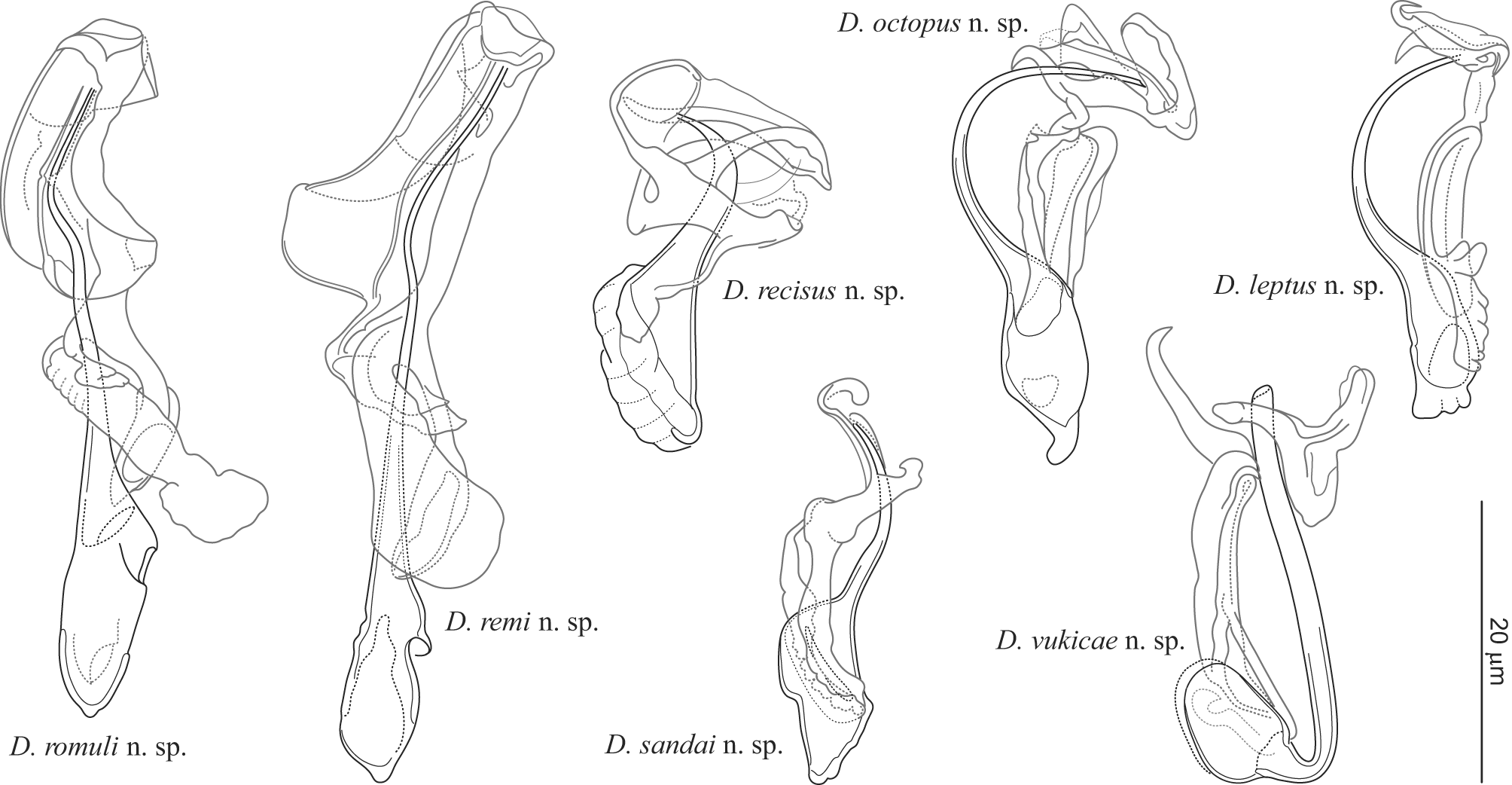Dactylogyrus on:
[Wikipedia]
[Google]
[Amazon]
''Dactylogyrus'' is a genus of
 Other characteristics of ''Dactylogyrus'' species include the appearance of four eye-spots, 14 marginal hooks (7 pairs), one to two connective bars and two needle-like structures and spindle-shaped dactylogyrid-type seminal vesicles.Woo, P.T.K, David W. Bruno, L. H. Susan Lim. Diseases and Disorders of Finfish in Cage Culture. Malaysia: CABI, 2002. ''Dactylogyrus'' has an adult structure that is up to 2 mm in length.
Other characteristics of ''Dactylogyrus'' species include the appearance of four eye-spots, 14 marginal hooks (7 pairs), one to two connective bars and two needle-like structures and spindle-shaped dactylogyrid-type seminal vesicles.Woo, P.T.K, David W. Bruno, L. H. Susan Lim. Diseases and Disorders of Finfish in Cage Culture. Malaysia: CABI, 2002. ''Dactylogyrus'' has an adult structure that is up to 2 mm in length.
monogenea
Monogeneans are a group of ectoparasitic flatworms commonly found on the skin, gills, or fins of fish. They have a direct lifecycle and do not require an intermediate host. Adults are hermaphrodites, meaning they have both male and female reprod ...
ns in the Dactylogyridae
Dactylogyridae is a family of monogenean flatworm
The flatworms, flat worms, Platyhelminthes, or platyhelminths (from the Greek πλατύ, ''platy'', meaning "flat" and ἕλμινς (root: ἑλμινθ-), ''helminth-'', meaning "worm") are ...
family.
Like other monogeneans, species of ''Dactylogyrus'' only have one host required to complete their life cycle.
Introduction
Members of ''Dactylogyrus'' (common name: Gill Fluke) are oviparous (egg-laying) monogeneans trematodes that have two pairs of anchors. These anchors can be used to latch onto the gills of a host, particularly freshwater fish such as carp. In heavily infected fish, ''Dactylogyrus'' can also be found on the buccal cavity, and at times fins and skin of the freshwater fish.Species
''Dactylogyrus'' is one of the most speciose genus of helminths, with more than 900 species described. Consequently, in 1996, it was estimated that the taxonomy was "in a state of considerable confusion".Anatomy
 Other characteristics of ''Dactylogyrus'' species include the appearance of four eye-spots, 14 marginal hooks (7 pairs), one to two connective bars and two needle-like structures and spindle-shaped dactylogyrid-type seminal vesicles.Woo, P.T.K, David W. Bruno, L. H. Susan Lim. Diseases and Disorders of Finfish in Cage Culture. Malaysia: CABI, 2002. ''Dactylogyrus'' has an adult structure that is up to 2 mm in length.
Other characteristics of ''Dactylogyrus'' species include the appearance of four eye-spots, 14 marginal hooks (7 pairs), one to two connective bars and two needle-like structures and spindle-shaped dactylogyrid-type seminal vesicles.Woo, P.T.K, David W. Bruno, L. H. Susan Lim. Diseases and Disorders of Finfish in Cage Culture. Malaysia: CABI, 2002. ''Dactylogyrus'' has an adult structure that is up to 2 mm in length.
Life cycle
The life cycle of ''Dactylogyrus'' species is direct, having no intermediate host. The hermaphroditic adults are oviparous and produce eggs into the water which hatch prior to attaching to the gills of a fish host and developing into anoncomiracidium
An oncomiracidium is the ciliated and free-living larva of a monogenean, a type of parasitic flatworm commonly found on fish. It is similar to the miracidium of Trematoda, but has sclerotised
Sclerotin is a component of the cuticle of various A ...
.
Adult ''Dactylogyrus'' lay about 4-10 eggs per day. After the eggs hatch, water currents aid the free-swimming ciliated larva in reaching its host. Once eggs are released into the water and have hatched within 4 days time period at 20 °C, the free-swimming ciliated larvae then is required to find their host within a 6–8 hours time frame in order to survive.Karen Paul."Flukes(Gyrodactylus and Dactylogyrus)." pond-life.me.uk. Pond Life: Fish Health. 2007-2017 Prevalence
''Dactylogyrus'' species are monogenean parasites that are usually found on the gills of cyprinid fishes. The prevalence of ''Dactylogyrus'' infection on fish differ depending on the seasons. It was found that ''Dactylogyrus'' infections are at their greatest during late autumn or early winter. Correlation has also been found between the temperature of the water and the intensity of ''Dactylogyrus'' infection.Hanzelová, V. & Žitnan, R. (1985) Epizootiologic importance of the concurrent monogenean invasion in carp. J. Helminthologia 22: 277–283. It is also generally accepted that fish are exposed to increased ''Dactylogyrus'' infections during their spawning period.Symptoms
Cyprinid fish that are infected by ''Dactylogyrus'' species may have symptoms that include inflamed gills, excessive mucous secretions and accelerated respiration. Also increased movement of the gills due to damage (fibrosis
Fibrosis, also known as fibrotic scarring, is a pathological wound healing in which connective tissue replaces normal parenchymal tissue to the extent that it goes unchecked, leading to considerable tissue remodelling and the formation of perma ...
) the fluke is causing to the tissues. The infected fish also becomes lethargic, swims near the surface, and its appetite decreases. Additionally the infected fish may hold its gill covers open and scratch its gills on rocks.Dawes, John. Complete Encyclopedia of the Freshwater Aquarium. Firefly Books, 2001.
In severe infections, ''Dactylogyrus'' species can cause hemorrhaging and metaplasia
Metaplasia ( gr, "change in form") is the transformation of one differentiated cell type to another differentiated cell type. The change from one type of cell to another may be part of a normal maturation process, or caused by some sort of abno ...
of the gills which can lead to secondary bacterial infections and death. Heavily infected fish are also anorexic and can be found gasping for air and exhibiting abnormal behavior such as jumping out of the water.
Treatment
A primary method for control of ''Dactylogyrus'' species is the application of chemicals. Treatments includePraziquantel
Praziquantel (PZQ), sold under the brandname Biltricide among others, is a medication used to treat a number of types of helminthiasis, parasitic worm infections in mammals, birds, amphibians, reptiles, and fish. In humans specifically, it is us ...
, salt baths, formalin or organophosphates, fenbendazole, albendazole, Bromex-50 and potassium permanganate.
References
External links
{{Taxonbar, from=Q174912 Dactylogyridae Monogenea genera